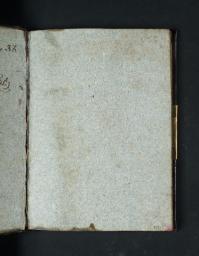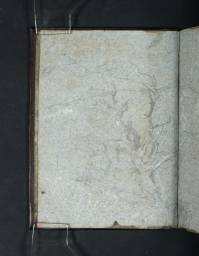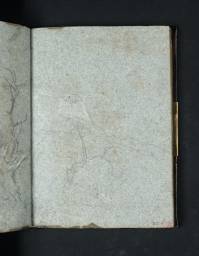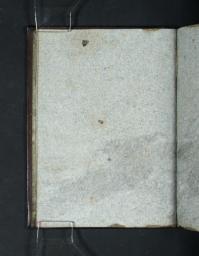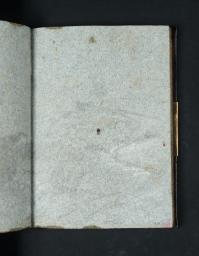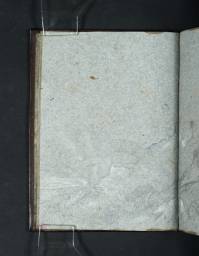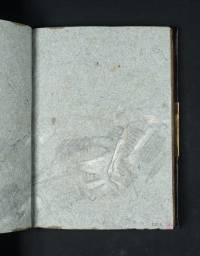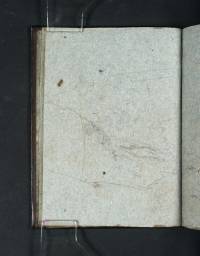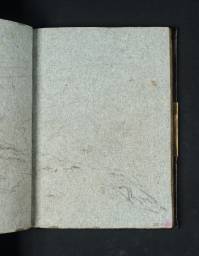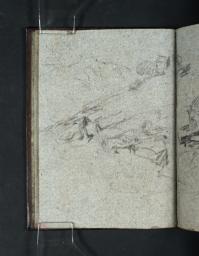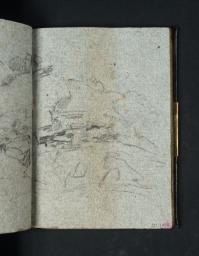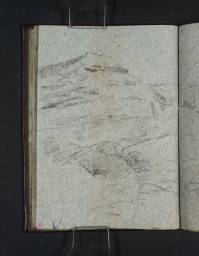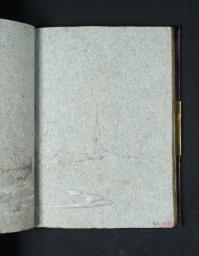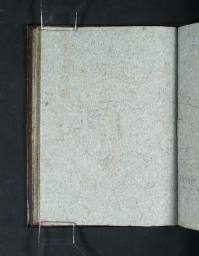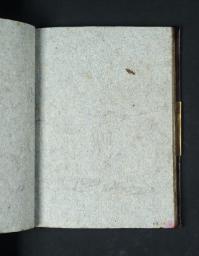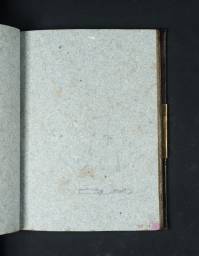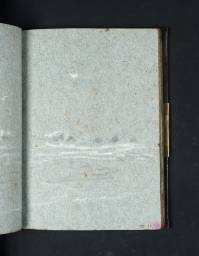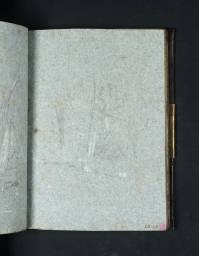Turner Bequest LII 1–51
Sketchbook bound in boards covered in calf leather, gold-tooled at the edges and spine, with one broken brass clasp
51 leaves of coarse blue laid paper, 143 x 111 mm
Numbered 347 as part of the Turner Schedule in 1854, and endorsed by the Executors of the Turner Bequest, Charles Turner, John Prescott Knight and Charles Lock Eastlake in ink ‘No 347 Contains 36 | Leaves in Pencil | C Turner’ and in pencil ‘JPK’ and ‘C.L.E.’ inside front cover, at top
Blind-stamped with Turner Bequest monogram inside front cover, above left of centre
Inscribed in pencil ‘LII’ inside front cover, top left
Stamped in black ‘LII’ inside front cover, top left
51 leaves of coarse blue laid paper, 143 x 111 mm
Numbered 347 as part of the Turner Schedule in 1854, and endorsed by the Executors of the Turner Bequest, Charles Turner, John Prescott Knight and Charles Lock Eastlake in ink ‘No 347 Contains 36 | Leaves in Pencil | C Turner’ and in pencil ‘JPK’ and ‘C.L.E.’ inside front cover, at top
Blind-stamped with Turner Bequest monogram inside front cover, above left of centre
Inscribed in pencil ‘LII’ inside front cover, top left
Stamped in black ‘LII’ inside front cover, top left
Accepted by the nation as part of the Turner Bequest 1856
References
This is one of eight sketchbooks that Turner took with him on his tour to the Scottish Highlands in the summer of 1801; see the Introduction to the Helmsley sketchbook (Tate; Turner Bequest LIII). Many of its leaves are blank. Gerald Wilkinson explains the title that appeared on Turner’s label (now lost) as shorthand for ‘drawings done on the shore while staying at Guisborough’,1 a small town five miles from the North Yorkshire coast, interesting itself for the fragmentary but striking ruins of an Augustinian priory. Turner does not seem to have drawn these, though his colleague Thomas Girtin (1775–1802), who also spent much time in Yorkshire, apparently did: a small oil study in the Yale Center for British Art, New Haven, is plausibly attributed to him.
However, at least one drawing in this sketchbook, on folios 14 verso–15 recto and 16 recto (D02414–D02416), seems to show the characteristic silhouette of the cliffs at Whitby, twenty miles down the coast to the south-east, which might suggest that the book was used at different halting-places. Alternatively, that sketch may have been made at Scarborough, though that is considerably farther south. Both towns feature among subjects in the Dunbar sketchbook (Tate; Turner Bequest LIV), which consists of drawings that are in many respects, as Wilkinson points out, similar to those in the Guisborough Shore book,2 though usually considerably more elaborate.
At whatever point on the coast they were made, the drawings in this book all seem to belong to the same moment. Several are of the cliffs of the Northumberland coast; the majority are rapid notes that, as Wilkinson suggests, ‘probably represent an unpremeditated attempt to study the violent movements of water’.3
According to Finberg, the sketchbook bore Turner’s label (since lost) on its spine, reading ‘30 Guisb. Shore.’4 Finberg also records John Ruskin’s endorsement on a wrapper: ‘347. Bold early outlines on poor (?) paper book – of little value.’5 The inside of the front cover is blind-stamped with the Turner Bequest monogram; otherwise the book is unstamped.
How to cite
Andrew Wilton, ‘Guisborough Shore sketchbook 1801’, sketchbook, May 2013, in David Blayney Brown (ed.), J.M.W. Turner: Sketchbooks, Drawings and Watercolours, Tate Research Publication, April 2016, https://www

